Paddle On: Access to the Eau Claire River is better than ever.
Wednesday, October 9, 2019
Lauren Fisher | VolumeOne | Photos by Andrea Paulseth, Roy Atkinson, Stacey Segelken, Nick Meyer
HOW CAN A COMMUNITY OF POND PADDLERS AND LAKE LOVERS EMBRACE THE CHALLENGES AND OPPORTUNITIES PRESENTED BY MORE EXCITING WATERS?

More Information >>
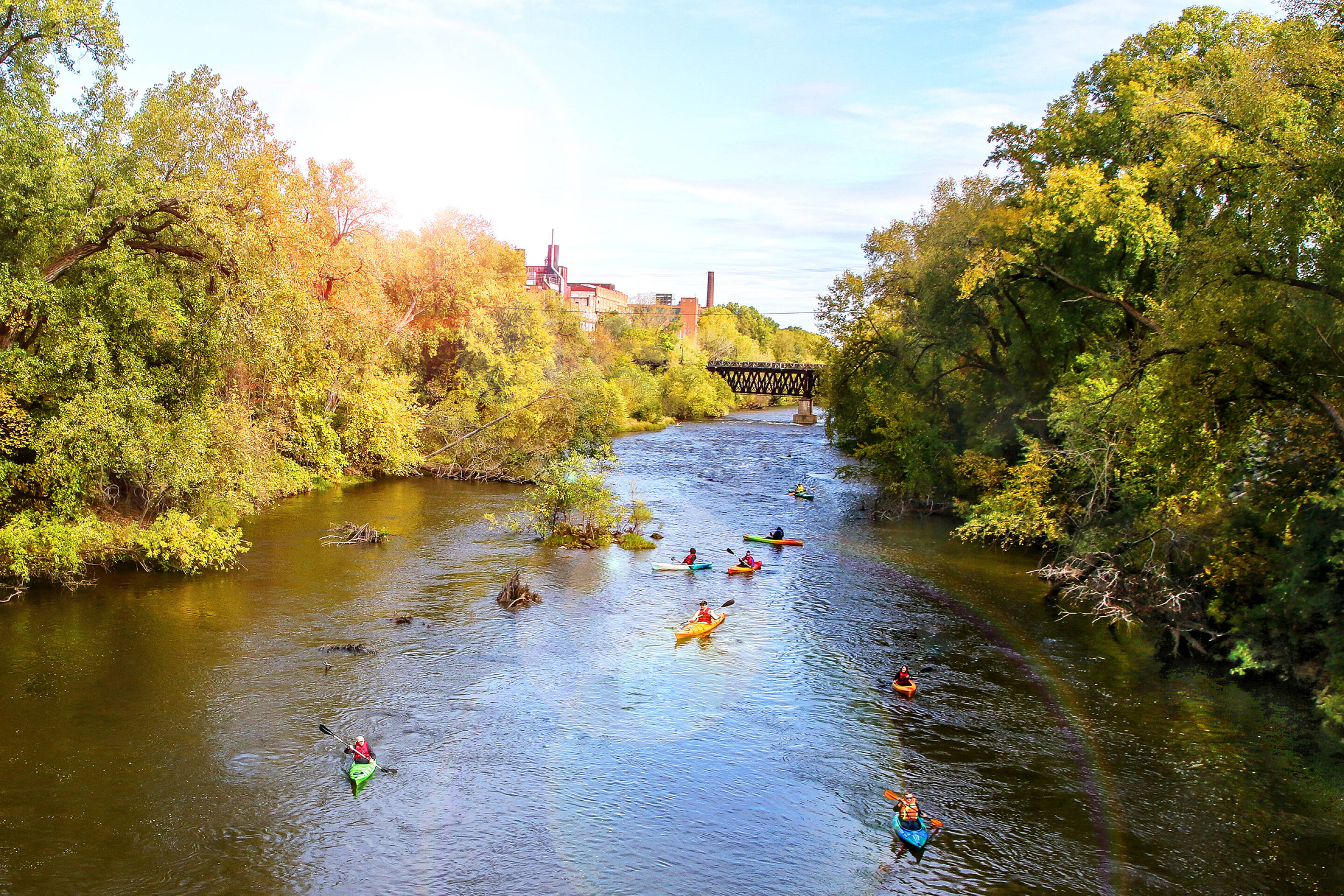
When Stacey Segelken's canoe flipped over on the Eau Claire River on July 21, she wasn't worried about her own safety.
"The only moment of panic was when we couldn't see the dog," she recalled. She and her husband, Josh Lindgren, searched frantically for a moment before the canoe righted itself, revealing Otis, their 30-pound mutt, alive and well and lookin' snazzy in his own doggy life jacket.
Things had started to look rough when they approached the Dewey Street Bridge. The rapids were higher than Segelken had ever seen at that location, but there was no place to exit the water. They made it through the first set of rapids all right, but the second was even bigger - she doesn't know how they flipped, but they did.
Once she got her bearings, Segelken set about recovering the items they had lost in the flip. She swam ahead to grab their oar, but wasn't able to catch up with one of their towels and a water bottle. "Sorry for being a litter bug, EC River," she said.
She and Lindgren grabbed onto the canoe and floated the rest of the way to the confluence of the Eau Claire and Chippewa rivers, where they exited the water at Phoenix Park. As they made their way, legs up and feet downriver to avoid catching or hitting river debris, onlookers called down from the Farwell Street bridge and the banks, offering to dial the Fire Department for a rescue. The duo shouted back thanks, and that they were fine.
Only her pride as an experienced boater was injured that day. "I just felt stupid that I'd pushed to keep going, and we were going to be fine; all three of us had life jackets on," she said.
Every summer, floaters and boaters take to the river in Eau Claire, valiantly serving as captains to kayaks and canoes, tubes and magnificent giant inflatable swans. During the prime floating months of May-August in 2018, only six such ventures resulted in a response by Eau Claire Fire and Rescue. This year, the number of responses during the same time nearly doubled; Eau Claire Fire and Rescue responded to 11 reports resulting in water searches, watercraft recoveries, and swift water rescues on the river.
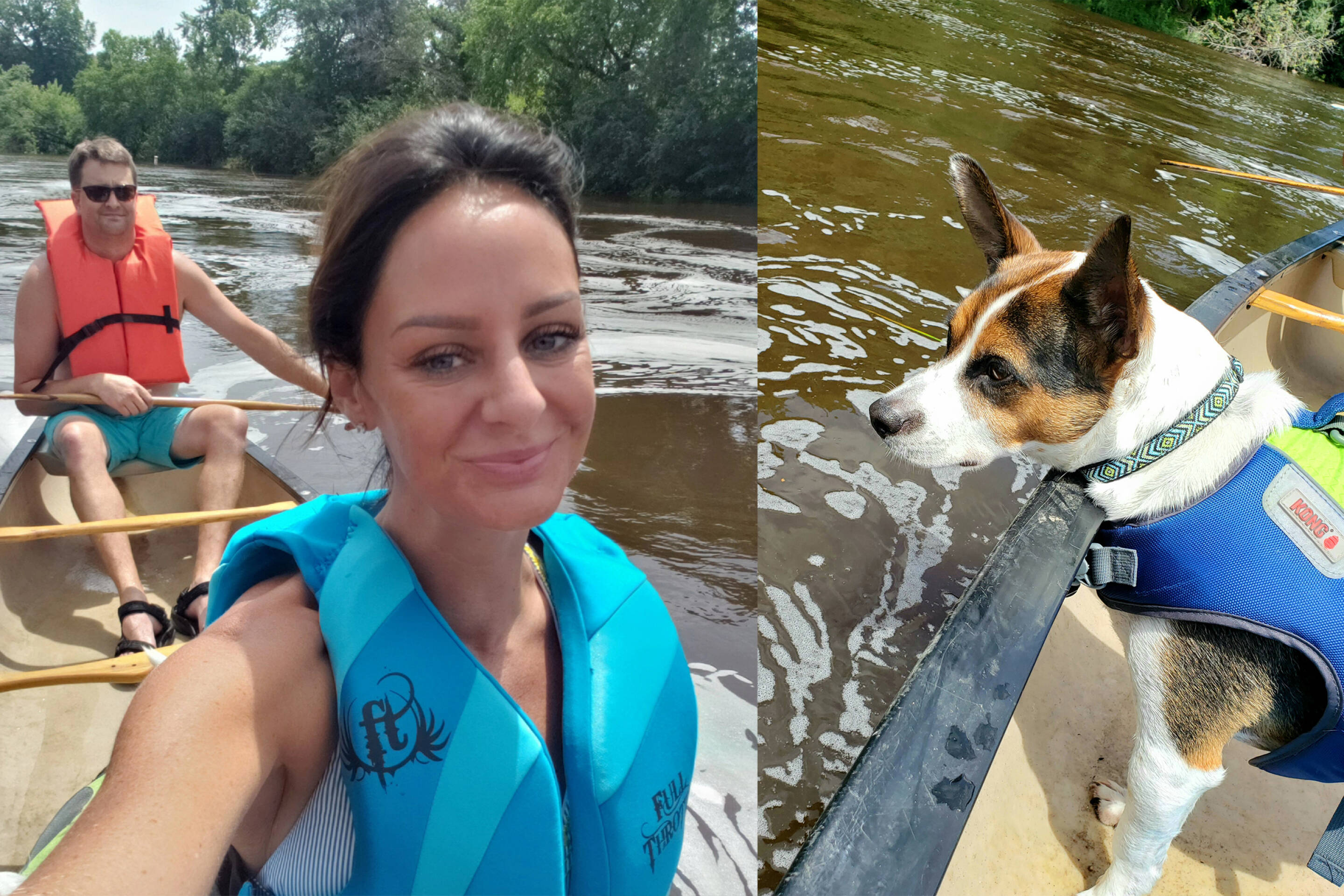
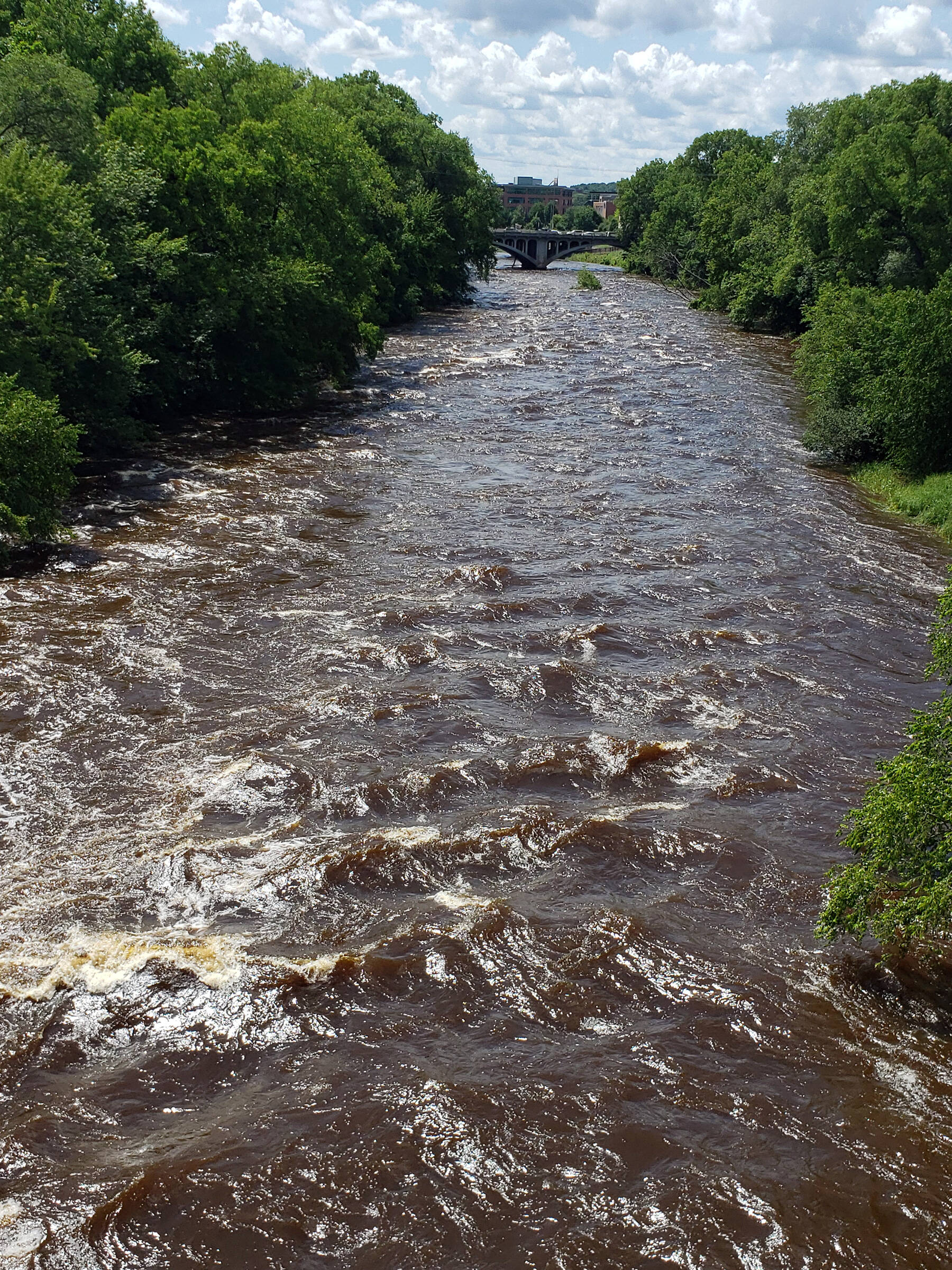
Eau Claire River, east of the Dewey Street bridge, during a peak water level - photos by Stacey Segelken
Eau Claire safety officials attribute the spike in activity to a number of causes. Due to a large melt-off from winter snow and several rainy spells, water levels were higher for more of the season than in past years. The increasing popularity of River Prairie Park and its boat landing might have also attracted more activity to the Eau Claire River, which recreationalists might not be as familiar with. Community leaders say that the increased rescue activity is an opportunity for education, collaboration, and even entrepreneurship.

Eau Claire River at the S-Bridge
"Growing up in Eau Claire, we never went out on the river," Segelken said. "Phoenix Park and River Prairie have made it so much more accessible."
But from logging to manufacturing and beyond, the Chippewa Valley community has always had a connection with its waterways. "It's just part of Eau Claire," she said. "It's part of our history, it's part of who we are."
We can thank the college students of yore for the advent of floating on the Chippewa River,
says Patrick Rolbiecki, owner of Riverside Bike & Skate in Eau Claire. Some hot summer day 20 or 30 years ago, young people took to the water. "That is what I feel turned this community's eyes to the rivers that we had in our area," he said.

The Valley's relationship with its waterways, from fishing to floating and picnicking to paddling, has come a long way since then, with the development of two water access points in Eau Claire and Altoona.
"The Chippewa River transformed when Phoenix Park was developed and RCU went in, and suddenly there's people using the river," Altoona City Administrator Mike Golat recalled. "They hadn't used it for years and years and years, and all of a sudden there's 300 kids floating down the river on a hot day in the summer."
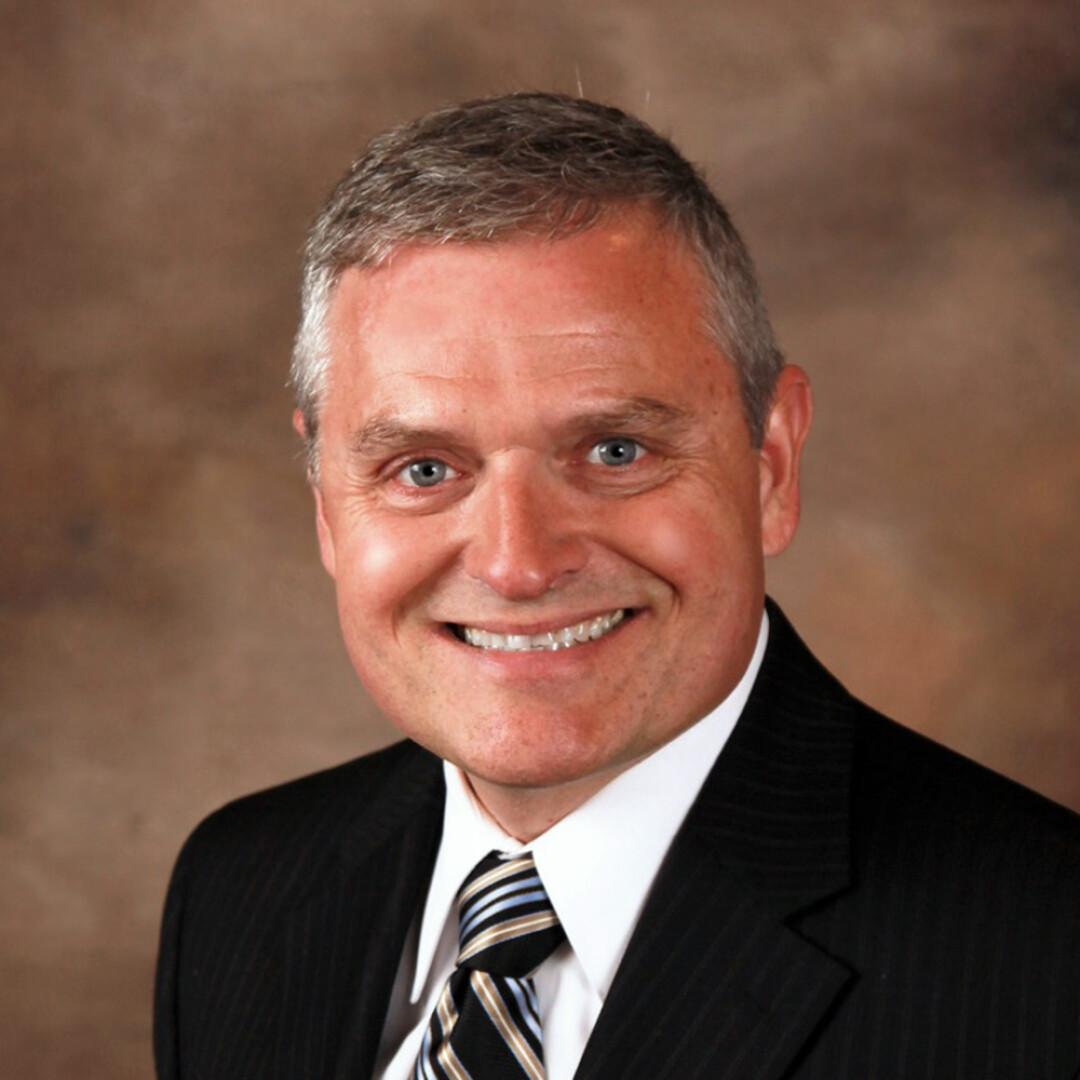
Mike Golat, Altoona City Administrator
When the City of Altoona began development plans for River Prairie, multiple community input sessions showed that residents wanted water and nature access. Many people had walked their dogs, fished, and even bowhunted on trails by the Eau Claire River, Golat said. Others navigated tricky paths to put in kayaks and canoes by the Lake Altoona Dam.
During Golat's 14-year career with the city, one person lost their life trying to enter the river too close to the dam on a steep bank. The River Prairie development included trail paving and, in 2016, the opening of an auto-accessible boat launch under the U.S. Highway 53 bridge over the Eau Claire River, bringing the water safely within reach of the community at large.
The Eau Claire River has seen increased recreational activity since the completion of River Prairie's boat launch. Riverside Bike and Skate boat and kayak users, for example, continue to request more shuttle services to River Prairie as the scene develops, Rolbiecki said. By his estimate, about 75% of the shuttles he runs are trucks loaded with kayaks and canoes to put in at River Prairie now - in the past that number was closer to 15-20%.

photo by Roy Atkinson, Management Analyst/Deputy City Clerk of Altoona
The trip downriver from River Prairie to the confluence of the Eau Claire and Chippewa rivers at Phoenix Park can take one to two hours, depending on river conditions and a person's commitment to paddling. It's a fairly serene float for most of the journey.
"The fishing is good, the scenery is beautiful," Golat, who has made the trip many times over the years, said. Steep banks and lush tree canopies shield roadways and paths from view for most of the ride. "You don't even realize that you're in the heart of a city. It really was a hidden and underutilized gem that we are now able to enjoy," he said.
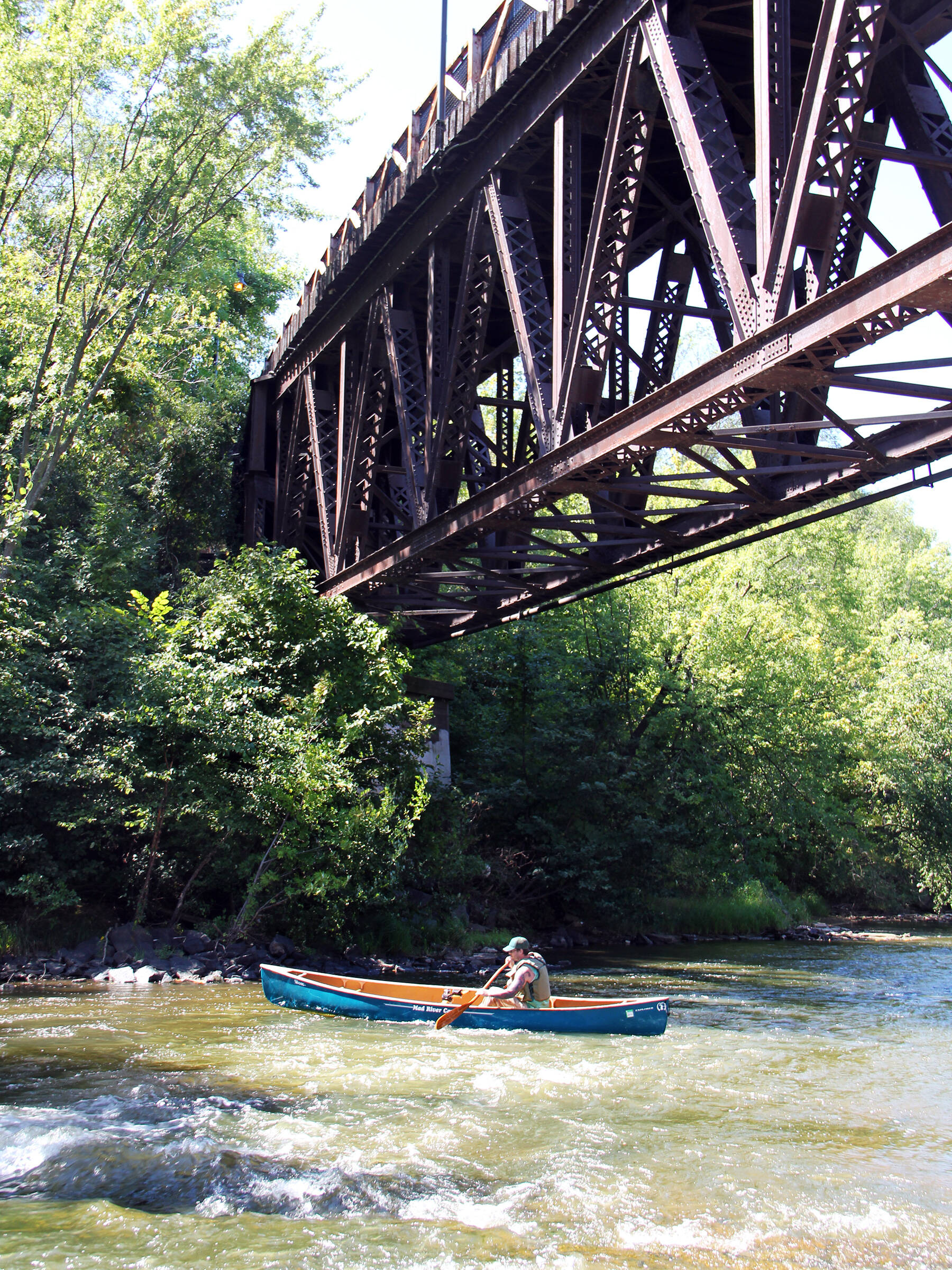
Eau Claire River, under the S-Bridge - photo by Nick Meyer
But residents who are used to floating the level, wide Chippewa might be taken by surprise as the much narrower Eau Claire passes under the S Bridge. The final stretch of river between here and the next safe water exit passes under four bridges and features technical challenges including a few riffles and "strainers," which are trees or debris that reach across parts of the waterway. Conditions change from day to day, hour to hour, and even minute to minute.
The Eau Claire river between River Prairie and Phoenix Park - specifically after the S Bridge - is a class II or III river depending on the water levels, weather, and other conditions, according to competitive whitewater paddler Glenn Felske. "You need to be able to maneuver through whitewater rapids, read the river so you don't run into trouble, and you need to be able to self-rescue," Felske said. (See classification chart for more information on river ratings)
"But you know what, that's what makes it fun," Golat said. "If it was just dead flat the whole way, it'd be boring as hell. It's much more interesting when the water conditions are challenging."

Click here to enlarge >>
The Altoona boat launch has made the Eau Claire River more accessible to casual paddlers and floaters, who might be less experienced than the persistent paddlers who once braved steep banks to put in.
At normal water levels, the River Prairie landing provides access to a great float for novice and experienced paddlers, Rolbiecki said, as long as people make sure their skillset is up to the river and to current conditions.
"It's in the city, so people think that they can just do it and there's nothing to it. But you have to know how to canoe or kayak when you go down there."

Eau Claire River
Not all publicity is good publicity
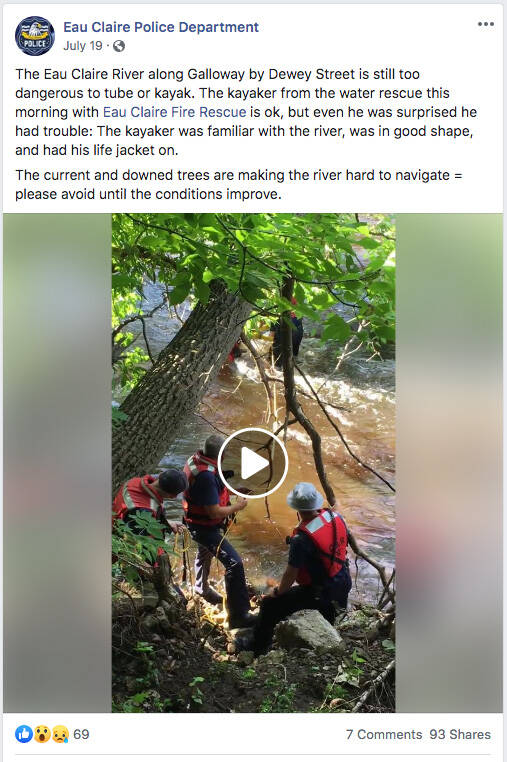
(the video is no longer published)
During Independence Day weekend, three rescues occurred on the Eau Claire River. The Eau Claire Police Department posted images of active currents between the S Bridge and N. Dewey St. to Facebook.
Their July 6 message read: "With hot temperatures comes tubing. Several have been launching at River Prairie and floating to Phoenix Park. There has been some calls for help between the "S" Bridge and North Dewey Street for floaters tipping their kayaks and tubes. This area of the river is not safe and we encourage people not to navigate through this section at this time."
A July 22 report from WQOW TV was ominous:
"High water in the area has led to a rise in water rescues. "So far in 2019, the Eau Claire Fire Department has been dispatched to 35 water rescues as compared to 10 for all of last year."
But that's not quite true.
While Eau Claire Fire and Rescue records do indicate 34 water-related responses in 2019 as compared to 12 in 2018, part of the picture is missing. A "response," can indicate a rescue, where a person was recovered from the water, or a number of other situations, including a dispatch to investigate an abandoned boat or tube on the water, or a search for a missing person. Of the 34 responses recorded in 2019, 21 were efforts to locate a teenaged boy who jumped into the Chippewa River in April during high, cold water and was unable to recover and swim to shore, according to Eau Claire Fire and Rescue.
When these search efforts are taken into account, the number of responses to individual incidents this year drops from 34 to 14, two more than took place in 2018.
While there is no monitoring of the depth of the Eau Claire River in the central Chippewa Valley, Chippewa River recordings show that water levels spiked as the heavy snow from last winter thawed into our waterways in the spring. This led to "action-stage elevation" throughout much of May, meaning that the surface of the Chippewa River was near or at the top of its banks - and that the Eau Claire River was also moving quickly.

Click here to expand >>
The Chippewa River reached action stage once again during the week of July 20, following three days with almost 2 inches of rainfall. The Fire Department carried out two rescues on the Eau Claire River that week. Eau Claire resident Stacey Segelken also capsized her canoe on the Eau Claire River during this period, although she did not require rescue.
The Eau Claire Police and Fire and Rescue departments both issued several statements on social media over the course of the summer during high water discouraging people from entering the water, with the Police Department referring to the Eau Claire as "dangerous to tube or kayak," and "not safe," and the Fire Department advising that "the best prevention is avoidance, especially in high water situations." This, paired with an incomplete story regarding rescue statistics, inspired social media commenters to voice their concern.
When the water levels dropped back to "normal" range at the end of July, the perception of danger on the water stuck around.

Linda John, executive director of Visit Eau Claire
In early August, Linda John, executive director of Visit Eau Claire, was preparing to take to the Eau Claire River, but decided to call it off. She had heard that the waters were fast and high, and that there had been multiple rescues in prior weeks.
"I honestly didn't feel like I was that adventuresome to take the chance," she said. She is a frequent tuber of the Chippewa River, and loves lake kayaking, but after hearing about the summer's rescues, she decided taking to a rougher river was out of her wheelhouse.
"I would do it if it was lower and had better conditions," she said.
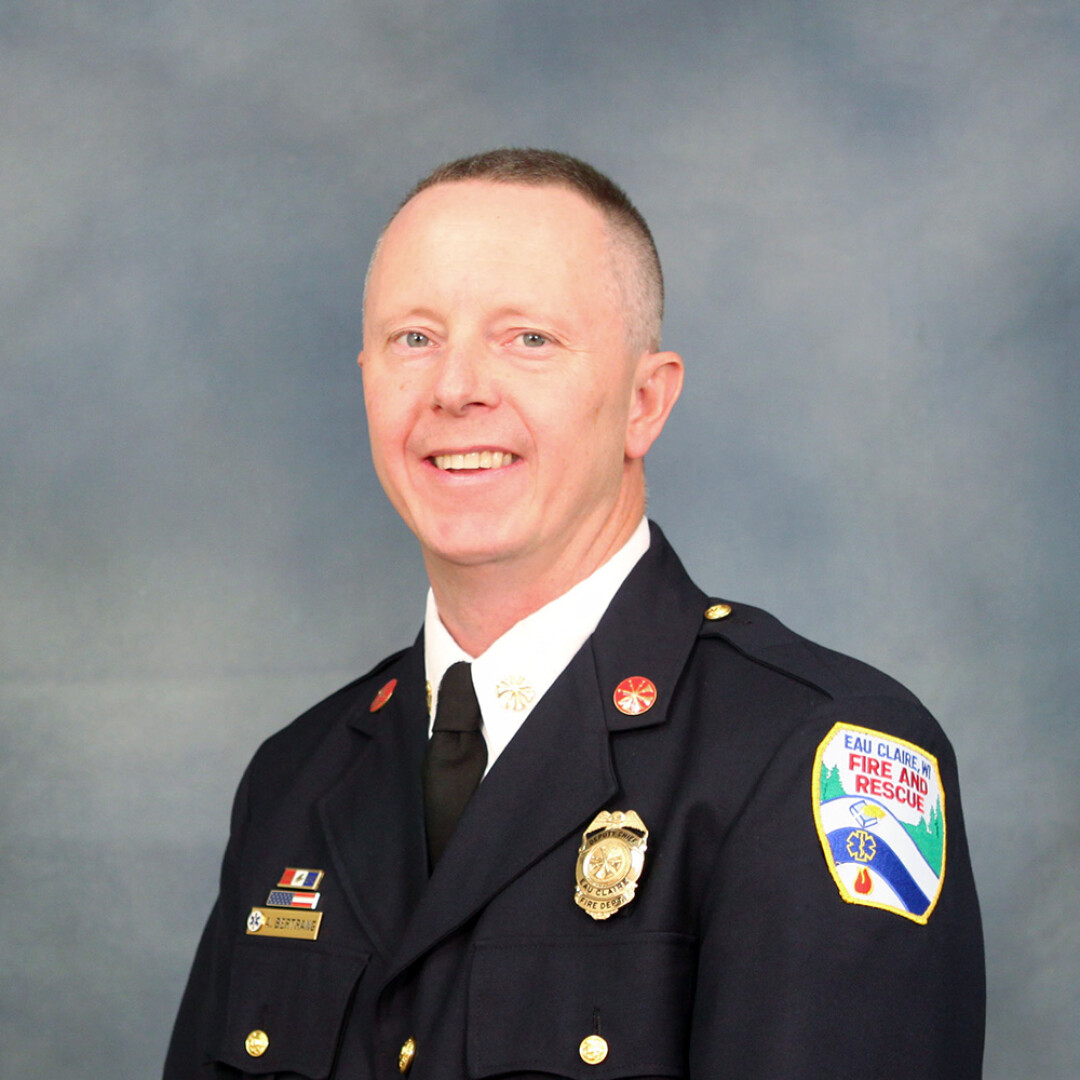
Al Bertrang, Deputy Fire Chief of the Eau Claire Fire Dept
For Deputy Fire Chief Al Bertrang of the Eau Claire Fire Department, safety is the highest concern.
"It's about measuring what the risks are, doing what we can to minimize those risks, and making a judgement call as to whether what we want to do is worth the risk we're taking," Bertrang said.
Bertrang is a long-time paddler, but the Eau Claire river isn't his cup of tea, so he's stayed off it. "When the water's high, there's a lot of strainers and safety factors involved, and when the water's low, it's low and it really wouldn't be as enjoyable," he said. He prefers the wide-open Chippewa for his kayaking escapades.
"I do think it's a better message to say 'don't go in there,' that (the Fire Department is) not recommending river usage at this time," Bertrang said. "I would hope that what we give as a message about public safety, that people would accept that."
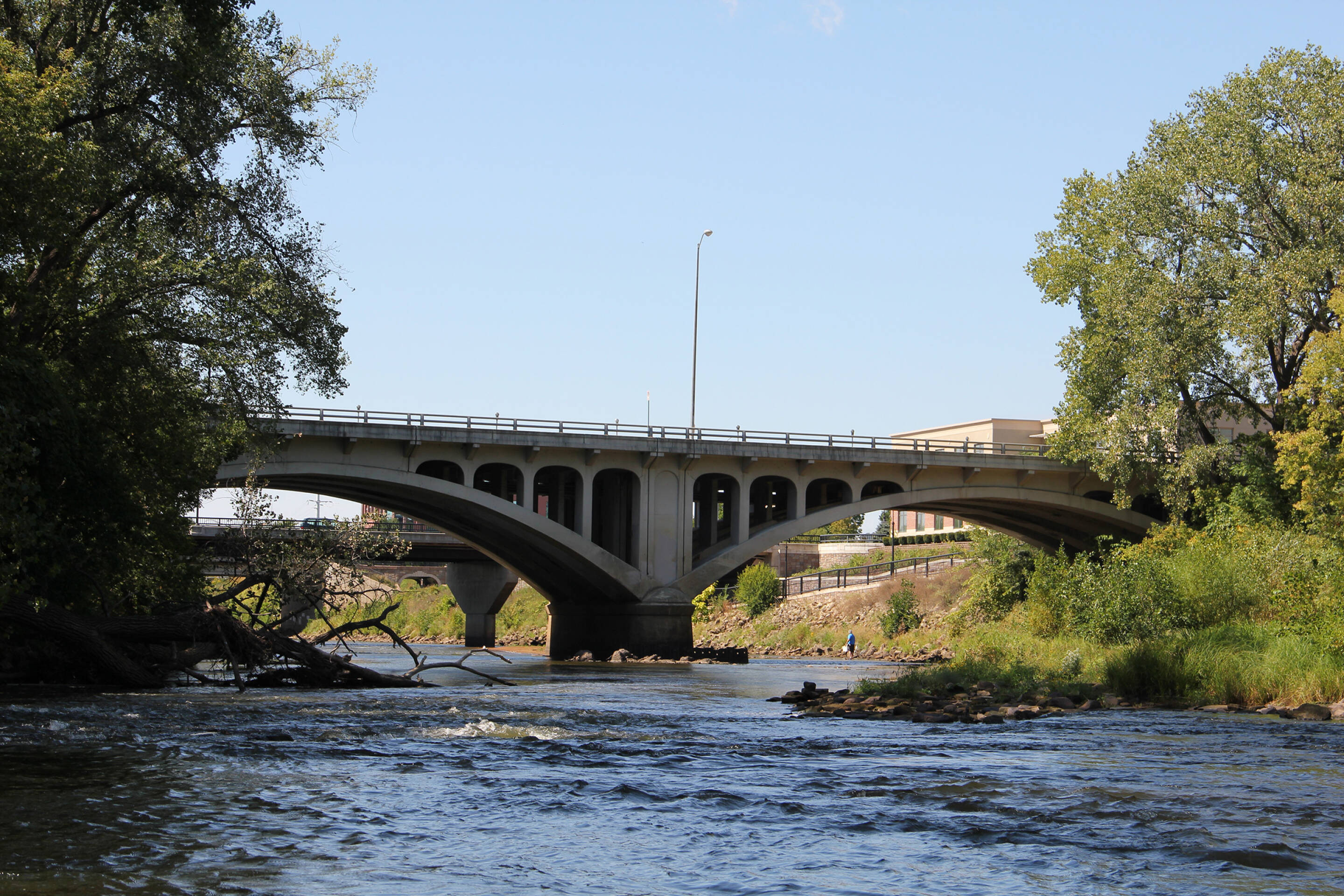
Dewey St. Bridge, Eau Claire Riever - photo by Nick Meyer
The Eau Claire River, while not a "whitewater" channel, can be challenging even for experienced paddlers at times, Rolbiecki, of Riverside Bike and Skate, said. He recalls floating with his grandparents and children one summer, and worrying for their safety as they dipped out of sight behind rapids ahead of him. (Everyone made it home safe that day.) In contrast, one summer he took to the water with an experienced, national-level competitive canoer during high water and raced from River Prairie to the Confluence in just 35 minutes, paddling like mad the entire way. The duo wore life jackets and stayed mid-stream, avoiding any obstacles, but he remembers the exhilaration of the ride.
Still, he advises everyone who takes to the river to play it safe. "I don't think caution is stressed enough with anybody," he said.
Opportunities Abound
Jim Falls whitewater paddler Glenn Felske has always been a little afraid of the water; but he lets that fear inform caution and education, rather than avoidance. It's the thrill of the ride that draws him to whitewater slalom races and difficult, technical routes. Now in his mid-50s, Felske has been paddling since he was a teenager, and has taught more than 300 people water the water safety they need to seek the same highs he loves so much.
"It's kind of like a bull rider riding a bull," Felske explained. "Why do they do it? The adrenaline rush."
Felske doesn't prefer the Chippewa River's generally calm, flat waters, and he only visits the Eau Claire River when the water is really moving.
By Felske's measure, Eau Claire could be doing much more to promote the Eau Claire River and the recreational opportunities it presents.
"If they put a whitewater park in Eau Claire, you'd have people coming from all over," Felske said. That would involve coordinating with the Altoona Dam and building in obstacles, as has been done in Wausau. Communities in other states, including Colarado and Idaho, are also exploring manmade whitewater courses.
"Why Wisconsin is falling behind is beyond me," Felske said.
Part of the journey to catching up, he says, is education. Paddlers should be adequately prepared to traverse the waters they decide to take on.
"If you get out there and you know what you're doing, it becomes fun and it becomes safer," Felske said. "If you want to be a racecar driver, you don't just jump into a car and start driving 200 mph - you'll crash." He encourages kayakers and canoeists to practice technical maneuvers, swimming, and self rescue on calm waters before ramping up to more difficult rapids.
Felske has taught self- and assisted-rescue and water safety to the Pure Water Paddlers, a Chippewa Valley kayak and canoe enthusiast group. The Paddlers often meet up to practice these skills and enjoy group paddles, and they welcome visitors who want to become more comfortable in the water.
The next part of the puzzle is for boaters to understand the waters they want to run - before they launch - says Pure Water Paddlers President Tim Wile II.
"Any time you go in the water, it's your responsibility to know what you're getting into," Wile said. With the Eau Claire River more accessible than ever, it might be tempting for inexperienced paddlers to take on without preparation or research, but Wile believes that over time the community will become more aware of the challenges the route presents.
"It seems like there's this little communication piece that Eau Claire's going to get used to in the next couple years: 'hey, watch for Dewey,'" he said.
Eau Claire Police and Fire and Rescue play a part by posting notices of water conditions to social media, and the Fire Department has made strides to partner with the City of Altoona on one proactive approach to safety.
In response to this year's Eau Claire River rescues, the City of Altoona and the Eau Claire Fire Department are collaborating to develop and post informational signs at the River Prairie boat landing. The goal is to notify users that there are some technical areas along the route, so that they can make informed decisions based on that knowledge and the water conditions on a given day.
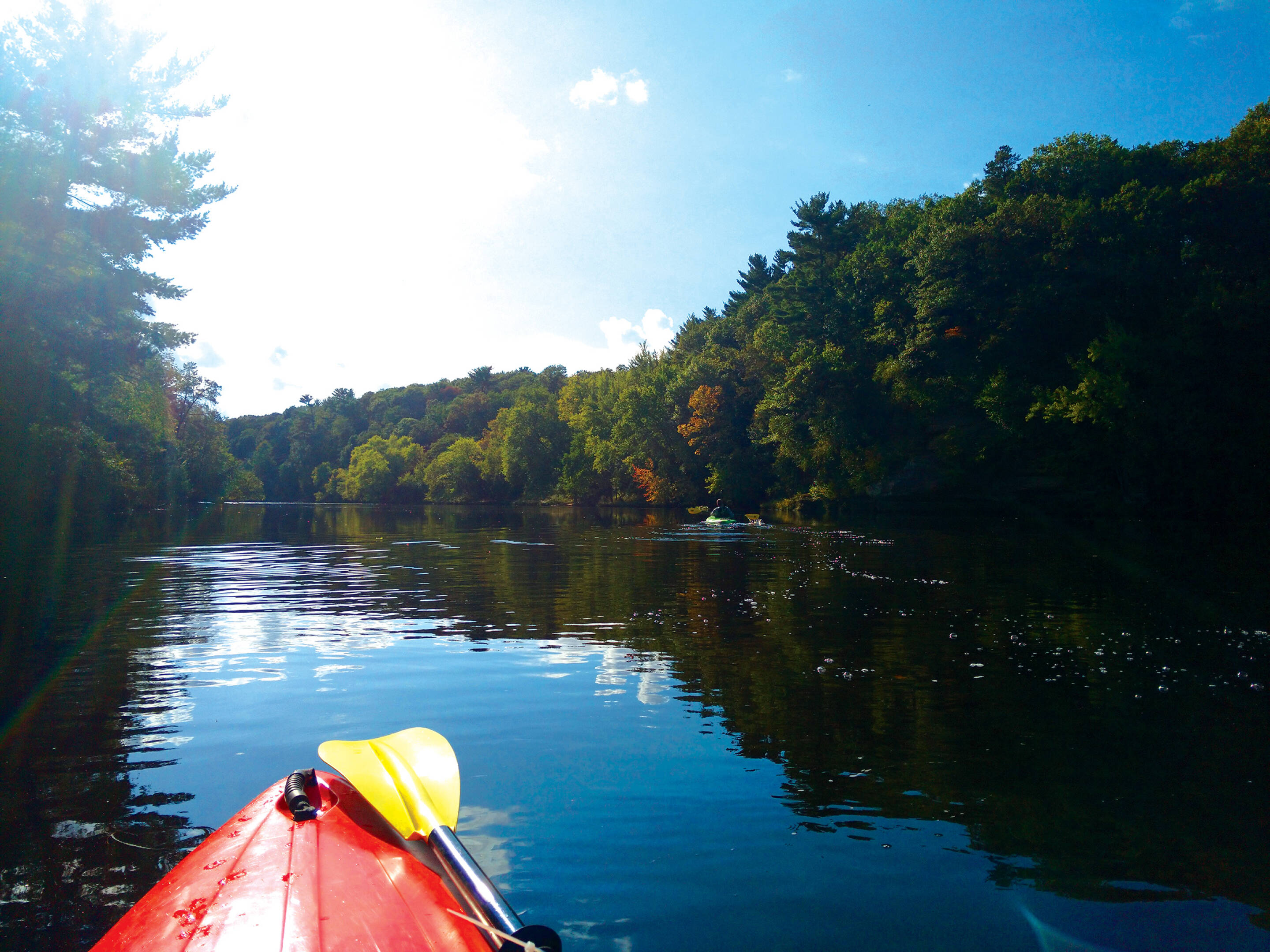
photo by Roy Atkinson
Mike Golat and Roy Atkinson, deputy city clerk of Altoona, are excited for the Eau Claire River's potential to host new water-centric events. There are hoops to jump through regarding planning and liability, but they would like to see kayak or canoe races connect Altoona with Eau Claire. Golat also has ideas for a fishing event.
"I think there's a lot of opportunities to take the situation and turn it into a more positive tourism opportunity," Linda John of Visit Eau Claire said. "That day that I wanted to go kayaking, if I could have hired a guide, I would have done it."
There is also the chance to develop public water recreation and safety programs using Visit Eau Claire event space, or perhaps grant funding. "If somebody would want to do that then I would love to talk to them," she said.
"A lot of cities harness their rivers as recreational amenities and it bolsters their tourism," Atkinson said. He likens the opportunities the Eau Claire River presents to what the Chippewa River State Trail provides the Valley community. "People come from all over to enjoy it. People should come from all over to paddle." Read more about this article »
|

